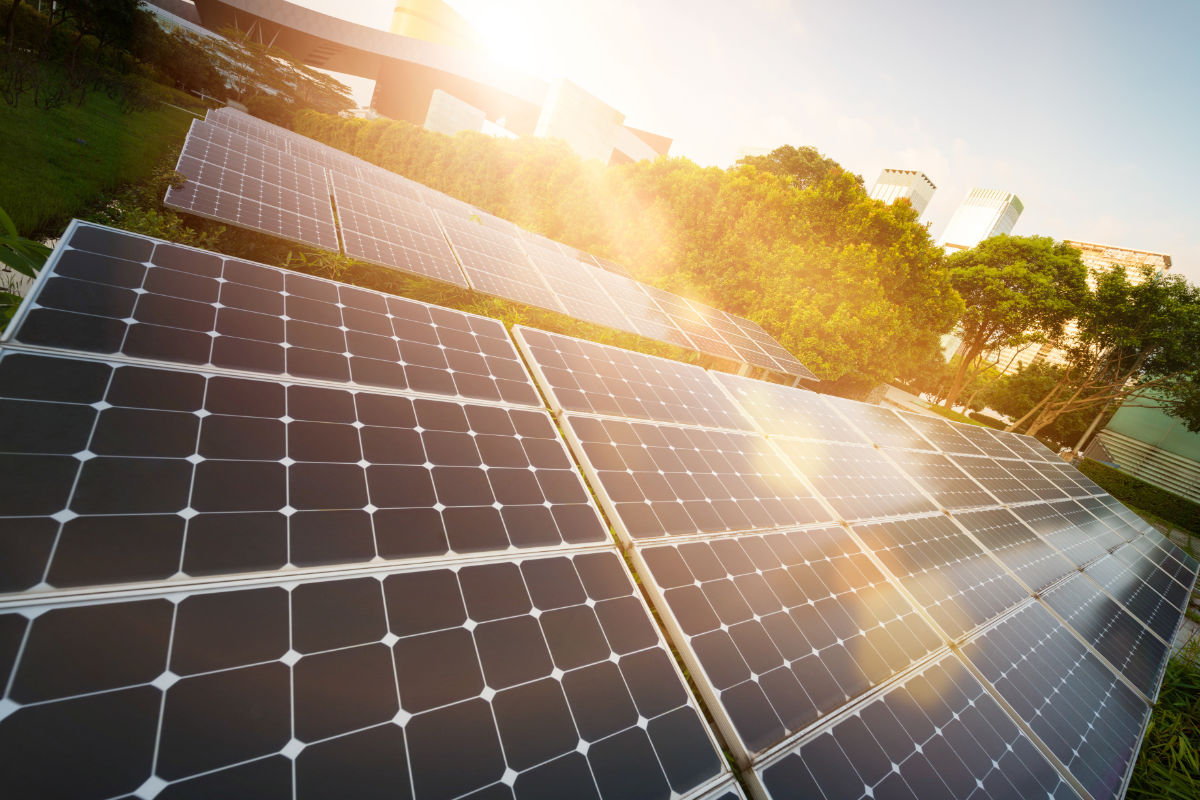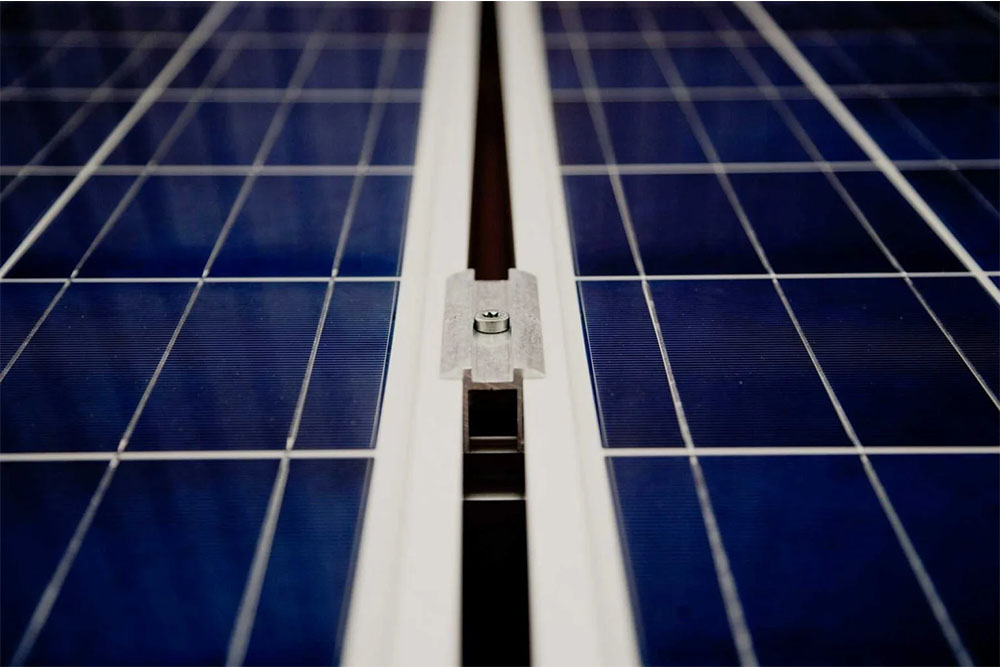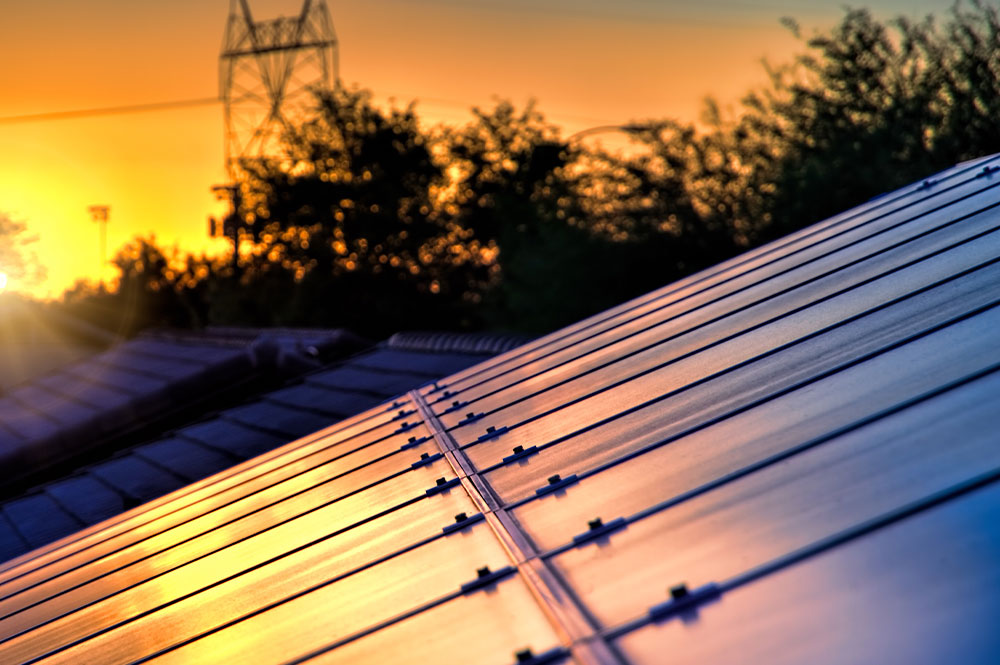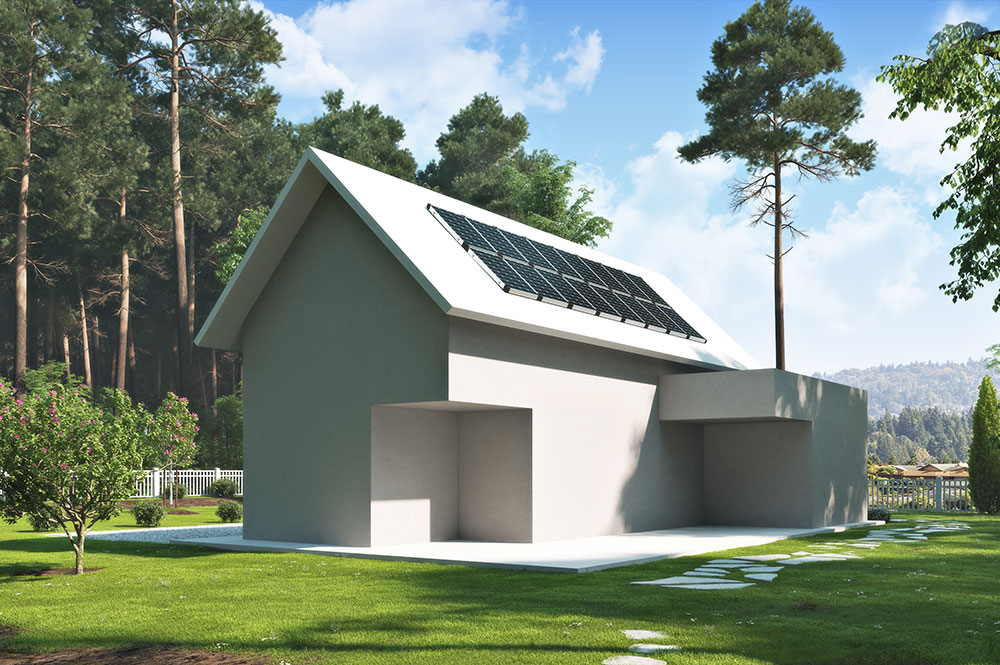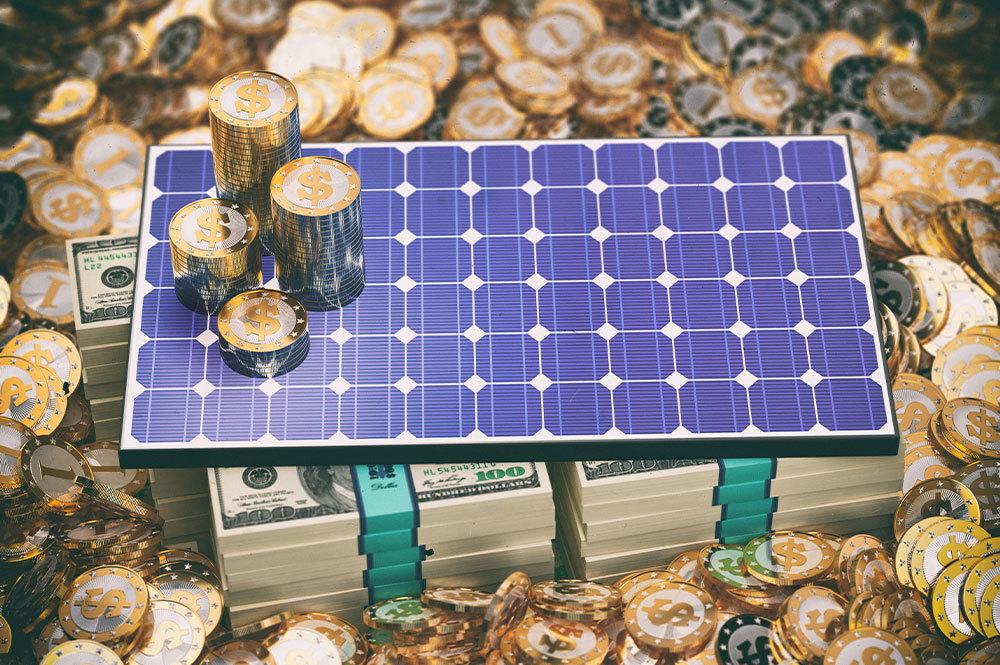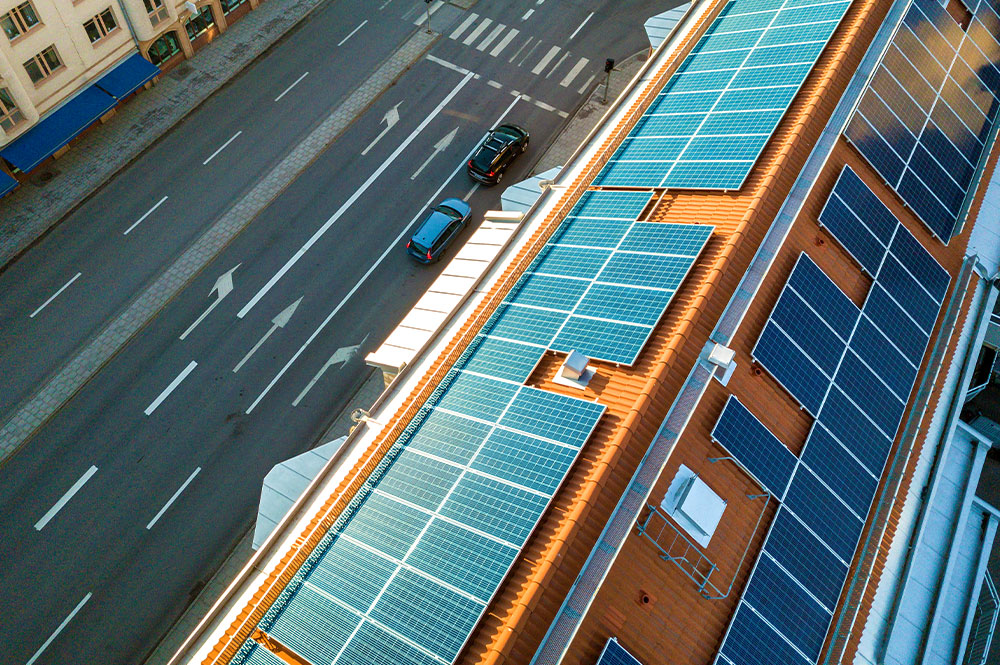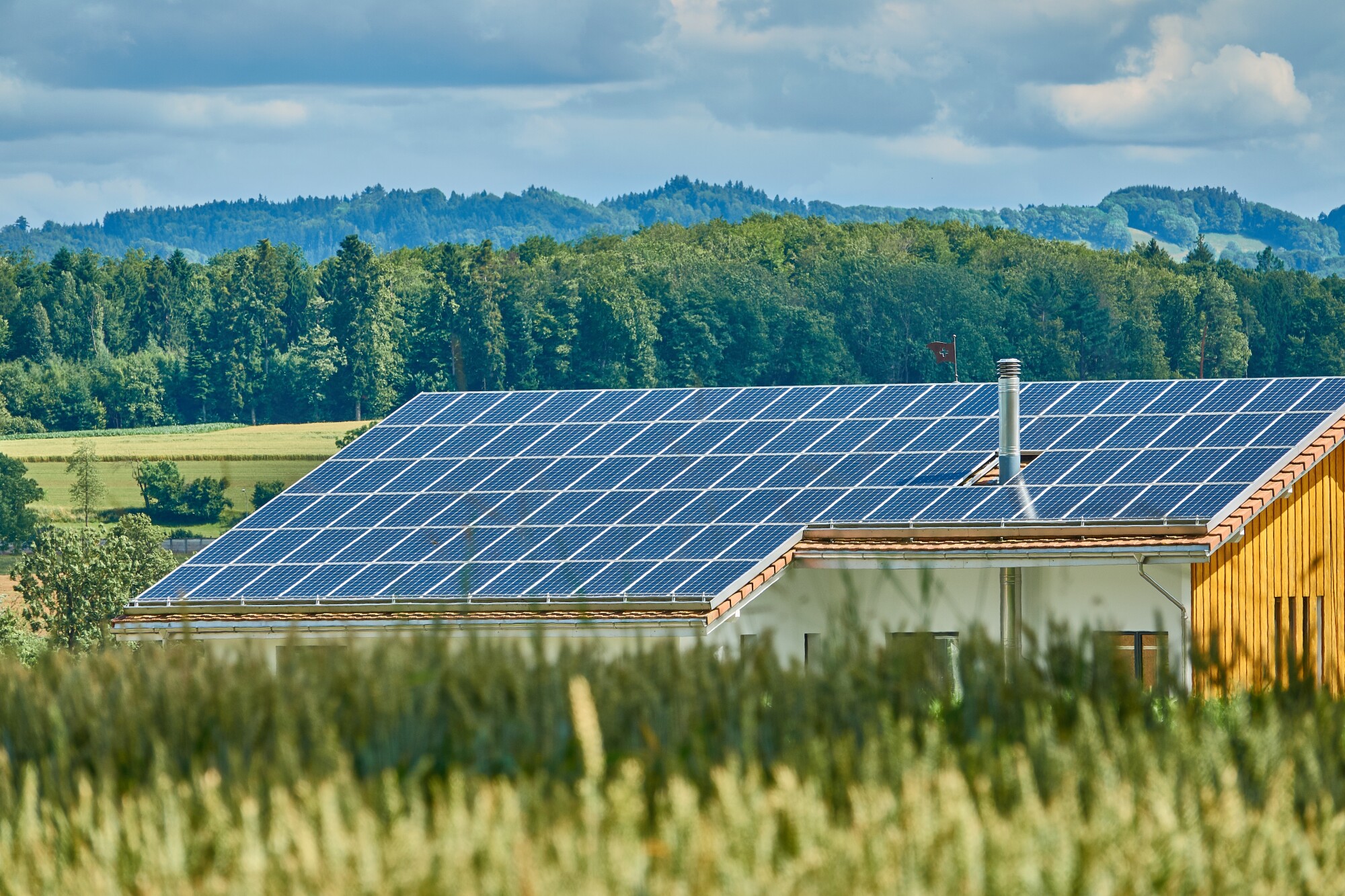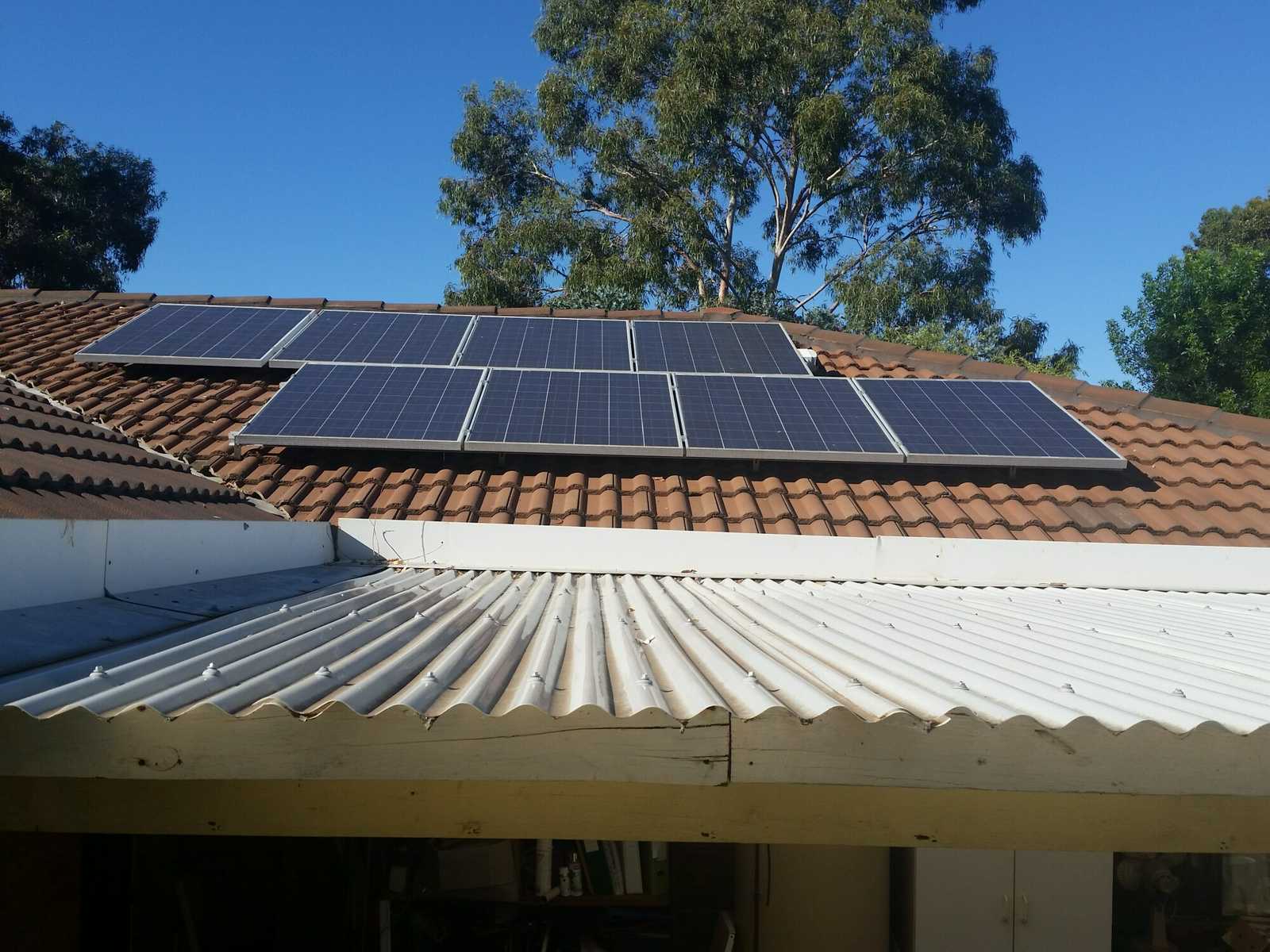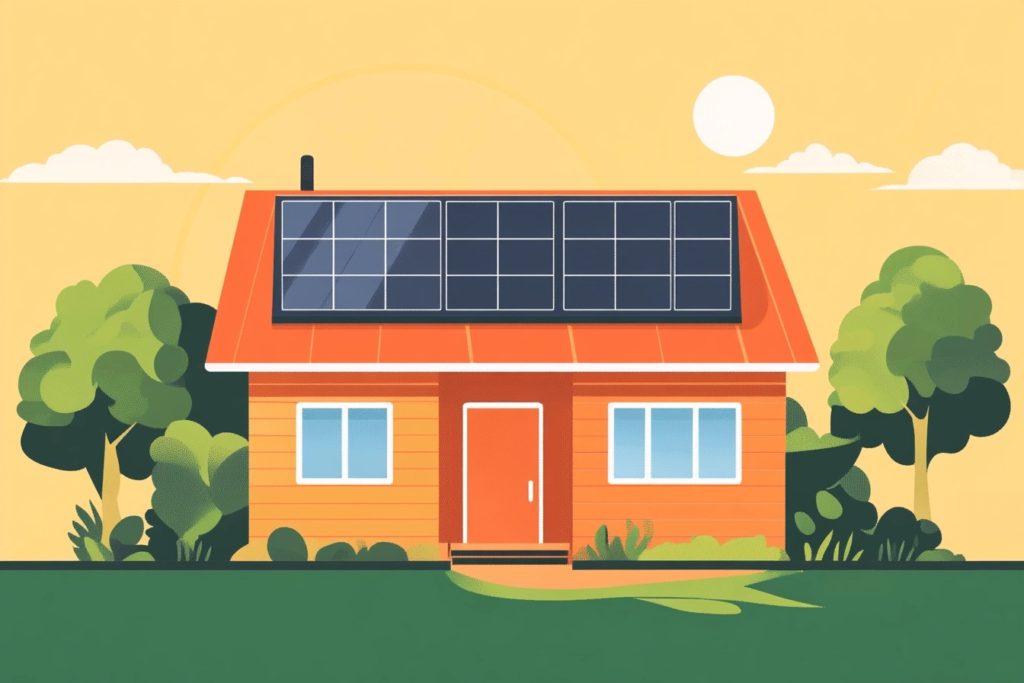How efficient are solar panels: the short answer
Different solar panel types come with different efficiency ratings, but most modern options fall anywhere between 13 and just about 25%.
Of course, the higher the efficiency rating, the higher the price tag as well. So, the goal is to just get the most efficient solar panel type for your budget instead of just shooting for the most efficient one out of all available options.
But what exactly are the options available to you? Let’s take a look at the most common ones:
Monocrystalline solar panels
Boasting an efficiency rating of around 20%—thanks to being manufactured using a single piece of pure silicon—monocrystalline solar panels are one of the most efficient options you have today.
But that’s not all they’re known for. They’re also highly regarded for their superior durability, making them perfect for homes located in areas with harsh weather conditions.
Unfortunately, these benefits all come at a price—literally. You see, monocrystalline panels are more expensive than most other options primarily because they are made using a single piece of pure silicon. Given the way they are manufactured, up to 50% of each silicon crystal used ends up wasted.
Polycrystalline solar panels
Slightly less efficient than their monocrystalline panels at about 15-17%, polycrystalline solar panels are perfect for you if you’re looking for a less expensive yet equally durable option.
These panels are manufactured using the exact same material as monocrystalline ones. The only difference is that instead of being made with just one crystal, they’re made using several cut up pieces. This means significantly less crystal gets wasted during manufacturing, which is exactly why they don’t cost as much.
PERC solar panels
Short for passive emitter and rear cell, PERC solar panels are pretty much the same as monocrystalline and polycrystalline ones in terms of the primary material used. The biggest difference is that they have an extra passivation layer behind their main cell, which does three simple things:
- Reflect sunlight back to the main cell, increasing the total amount that gets absorbed by the panel
- Resist the natural propensity of electrons to regroup, allowing them to flow more freely in the system
- Allow each panel to absorb higher wavelengths of light, preventing the back sheet from heating up and the panel’s efficiency from going down
The result is about a 5% increase in the overall efficiency of each panel—but that’s not all PERC panels have going for them. Aside from their top-notch efficiency, they’re also smaller than most other solar panel types, making them great for homes with limited roof space.
And, to top it all off, they also don’t cost significantly more than monocrystalline panels to produce, so they also generally don’t cost significantly more to acquire. So, if you’re already looking at getting the former, then you might want to consider spending just a little more to upgrade to the latter.
Thin-film solar panels
If you’re willing to sacrifice efficiency to save money, then thin-film solar panels may be the option for you. With an efficiency rating of just 13-15%, they’re the least efficient one out of the four solar panel types we’ve talked about today.
Is there a way to increase the efficiency of my solar panels?
Unfortunately, no, there’s no way to increase the efficiency of your solar panels. What you can do, however, is keep them working at peak efficiency for a long, long time.
First, you need to make sure that your home is solar ready. As a general rule, it should have a south-facing roof that slopes anywhere between 15 and 40 degrees and has unobstructed access to direct sunlight. In addition, the roof surface itself must be big enough to accommodate enough solar panels to generate the amount of power your household requires.
Second, you need to make sure that your solar power system is properly installed and set up. This means that unless you’re a certified expert when it comes to solar installations, it’s better to let a professional take care of it for you.
Finally, you need to make sure that your solar panels are not covered in leaves, snow, and other forms of debris, so be sure to clean them from time to time. And, if you spot signs of damage, get in touch with your solar provider immediately so they can fix the problem before it gets worse.
Given that most modern solar panels are designed to work at peak capacity for at least 25 years, if you have yours properly installed and keep them well maintained, you should be able to enjoy a healthy return on your investment.
Is efficiency rating everything?
The short answer is no, efficiency rating is not necessarily the be-all and end-all when it comes to choosing what type of solar panel to invest in.
While it may seem like going for the option with the highest efficiency rating is a great idea, there are actually several other factors you need to consider to ensure you get the right solar panel type for your specific needs and situation, such as:
- Your budget
- The size and condition of your roof
- The location of your property
- Your total power requirement
Let’s take a closer look at each one:
The first consideration is how much you have to spend on a solar power system. Even if you wanted to get the most efficient option, if you need to burn through your life savings to do so, then it might not be the best decision. Keep in mind that it takes time for solar energy systems to pay for themselves and become an actual asset.
Second, the size and condition of your roof would also dictate the type of solar panel you can use. There’s no point in going for the most efficient option if your roof is not big or strong enough to house it.
Third, you also need to consider your home address. if your property is located in an area that’s constantly exposed to harsh weather conditions, then you’ll also need to strike a balance between efficiency and durability when it comes to choosing the type of solar panel to use.
Finally, you need to remember that there’s more than one way to ensure your solar system meets your home’s power requirement. The goal is to find the most cost-effective setup that would last a long, long time—which doesn’t always require the use of the most efficient solar panels available in the market.
Long story short, if you want to make sure you get the perfect solar power system for your home, it’s best to hire an expert to not only help you choose, but also take care of installation, set up, and maintenance for you.
Is there a way to make switching to solar more financially feasible?
Absolutely! In fact, there are several ways for you to either significantly reduce or completely eliminate the upfront costs associated with switching to solar. Let’s take a look at the three most popular ones: solar loan, solar lease, and solar PPA.
Solar loans are just like any other kind of loan. They allow you to purchase your solar system without having to pay up front. Instead, you pay a significantly smaller monthly fee until the total cost of the system is paid off.
If you get your solar loan through LGCY Power, you’ll get access to benefits such as:
- Monthly payments lower than your energy bill
- System maintenance
- Product and workmanship warranty
- Federal solar tax credit and other government incentives
A solar lease, on the other hand, works pretty much the same way, taking the upfront cost of switching to solar out of the equation. The only difference is that if you choose this option, you won’t actually get to own the system. In fact, even the benefits are exactly the same when you get one from LGCY Power.
The third and final option we’ll be taking a look at today is solar PPA (power purchase agreement).
Unlike the first two options where you either pay in installments for the system or pay to borrow one, a solar PPA completely eliminates the need for you to purchase or lease a system. Instead, the solar company retains ownership of the system and you just pay for the amount of power you use—which typically costs less than what your utility company is charging you now.
The advantage of going with this setup is that you get to enjoy clean, affordable energy without having to worry about things such as depreciation and maintenance.
At the end of the day, it all depends on your needs.
If you prefer to have your own solar power system but don’t have the cash to pay for it up front, then a solar loan is your best bet.
If you just want a system installed but don’t mind not actually owning it, then a solar lease would be better for you. This option not only eliminates the need to pay for the system up front just like a solar loan, it also takes depreciation out of the equation just like a solar PPA.
Finally, if you just want more affordable energy but don’t want (or are unable) to install a solar power system in your home, then a solar PPA is exactly what you need.
What’s next?
Again, if you want to make sure you get the right solar power system for your home, the first step is to talk to a solar power specialist who can take care of not only helping you choose the correct system, but also installing, setting up, and maintaining it.
Book a no-obligation free consultation with one of our solar panel consultants today so we can answer all your questions and guide you every step of the way.
Getting a solar energy system for your home or business is a fantastic and reliable way to save money and protect the environment at the same time. It can also make your home more self-sufficient.
But it’s a big decision to make for your home. How much will it cost you? How long will your system last?
Do you know how to maintain solar panels?
These are all good questions that you should absolutely be asking yourself when shopping for a trustworthy solar energy system. But how easy it is to take care of them will astound you!
Read on to learn everything you need to know about maintaining your new solar energy system.
Where Is the Most Effective Place to Put Solar Panels?
You might find yourself wondering, “How do I get the most out of my solar panels?” The truth is that when you first buy your solar panels, they’ll be at their maximum efficiency. But placing them somewhere that doesn’t see a lot of sunlight might keep them from absorbing as much energy as they could.
This is why most people will have them put in sunny gardens or on top of roofs. For them to absorb as much sunlight as possible, you want them in a place that trees and debris won’t obstruct. This gives them full access to direct sunlight whenever it shines.
So putting them on top of your roof probably makes the most sense. The only issue is that this also exposes your solar panels to the elements. Rain, wind, and even snow will affect them every day.
The good news is that solar panels tend to be pretty sturdy. Many solar panels have even survived hurricanes.
Your main concerns might be if you live in an area of frequent tornados or large hail. If this sounds like you, then you might want to check that a warranty or homeowner’s insurance will protect your solar energy system.
Other issues you might run into are bird poop and pollen building up on your solar panels. While generally considered low maintenance, this kind of obstruction can prevent sunlight from hitting the solar cells as well as it should. Therefore, it can cause your system to run less efficiently.
What Causes Solar Panels to Degrade?
There is a name for when solar panels start to lose their efficiency: degradation. This can be the result of serious damage or obstruction on top of your solar panels. It will also simply happen naturally over time even if you take steps to maintain your solar panels.
You’ll notice that your warranty from the manufacturer will usually guarantee up to ninety percent efficiency for the first ten years. This is usually followed by another twenty years that guarantee eighty percent efficiency. This is out of a total of one hundred percent efficiency, which is what your solar panels will start with when they’re installed.
If you maintain them, the degradation process will be slow. Most solar panels made after the year 2000 degrade at a rate of less than one percent per year.
A solar panel is generally considered inefficient once it drops below eighty percent efficiency. But that doesn’t mean that it won’t still produce energy for your home. One of the oldest solar panels is sixty years old and is still producing energy.
However, it means that you will slowly start to notice that you’re not saving as much money on your energy bill every month. If this is alright with you, then you might not worry about it for a little while longer. However, like all things a solar panel won’t work forever.
Eventually, you will need to replace your solar panels to get the same energy efficiency you had before.
How to Maintain Solar Panels
The good news is that solar panels aren’t very difficult to maintain. You want to make sure that you’ve placed them where they won’t get pelted by falling leaves and twigs, but otherwise, you simply need to clean them every once in a while.
This process will serve to remove any dirt, pollen, or bird poop that has gotten on top of your solar panels. Any debris like this will prevent sunlight from reaching your solar cells. That means your solar panels won’t be generating as much energy for your home.
The good news is that if you live in an area that gets pretty consistent rain, then you shouldn’t need to do much. But if you go through a dry season or just don’t see any rain for a while, then you should take a garden hose and spray all the dirt off of your solar panels. This will remove any pollen and dirt from the solar panels.
If you have any stubborn pieces of bird poop stuck to your solar panels, a wet rag and some elbow grease should do the trick to remove this.
When it snows, you’ll want to remove it from your solar panels too. A garden hose with lukewarm water should melt ice and snow right off of the tops of them. Make sure it’s not hot water since interaction with snow would cause the solar panels to crack from the sudden change in heat.
Maintaining your solar panels in this way is the best way to keep them running efficiently for as long as possible.
How to Fix Solar Panels
The good news is that you can usually fix solar panels if they get damaged or cloudy. After a while, you may notice clouded plastic on your solar cells. This kind of clouding prevents sunlight from getting to the solar cells to generate power.
Rinsing and cleaning your solar panels isn’t going to help with this. You need something that’s going to clear the plastic for you.
Believe it or not, clear nail polish could be exactly what you need. Given the size of their cells, this trick is usually best used on a small solar light cell. All you need to do is spread some clear nail polish across the solar cells, careful not to get it on anything else.
Some people might be worried that this will reduce the amount of sunlight that can reach the solar cells, but that’s not true. In fact, it will make your solar panels more effective than if you let them stay cloudy.
The other thing you can do to fix your solar panels is getting experts to help you. If the problem isn’t that your panels are a little cloudy, then this is probably the best thing for you to do. Unless you are trained in fixing this equipment, you can easily break it if you try to do it yourself.
An expert will know exactly what to do to get your solar panel working right again, so you don’t have to worry about a thing.
Can Solar Panels Be Recycled?
Nothing lasts forever, and solar panels are no exception. No matter how well you take care of them, eventually, they will need to be replaced. Most solar panels are considered ineffective after twenty years, but yours may keep working just fine for longer than that.
But if solar panels eventually need to be replaced, what happens to the old ones? Are they recyclable?
The short answer to this is yes. They are indeed recyclable. The panel covers are usually made of plastic, which can be remade into something else.
But the reality is a little more complicated. While it’s completely possible to recycle degraded solar panels, it’s hard to get them to a place that will do that in the United States. Although many solar panels will be accepted by standard recycling companies.
The other option is that landfills will sell these solar panels second-hand. If the solar panel is still even somewhat usable, then it’s possible that it might still be useful to someone.
It’s also possible to recycle the panel itself in a way that recovers up to ninety percent of its solar cells for reuse. And the United States government is currently working on a way to make recycling solar panels cheaper for everyone.
This is good news because it encourages people to get their own solar installation. It means that people don’t need to worry about what will happen to their old solar panels when they need replacing. And with technology getting better all the time, soon you might see astounding lifespans from your solar panels.
Get Your Solar Energy System Today
So you can see that your solar energy system will last for a long time. It lasts even longer if you know how to maintain solar panels. Following the advice in this guide will make sure your solar panels are still producing energy after twenty years.
And the best place to get a trustworthy solar energy system for your home or business is here at LCGY Power. Our experts are delighted to help get you set up with clean solar energy today. Schedule a consultation today to get started!
The short answer is it depends. You see, there are a couple of factors that dictate just how much power you can squeeze out of a solar panel.
To find out, just ask yourself five simple questions:
Question #1: What is the solar panel’s wattage?
Most commercially available solar panels are designed to produce anywhere between 250 and 400 watts of power. The higher the wattage, the more power it can generate.
Question #2: What type of solar cell does the panel use?
When it comes to silicon solar panels, for example, there are two primary solar cell types to choose from: monocrystalline and polycrystalline. The former typically generates more power than the latter.
Regardless of the type you go with, though, silicon solar panels are still the most popular option right now because they strike the perfect balance between cost, efficiency, and lifespan.
Question #3: How many cells does the panel have
Solar panels typically come with either 60 or 72 cells, and the more cells a panel has, the more power it can generate.
This, however, doesn’t mean you should automatically go with 72-cell panels. Your choice would ultimately depend on how much roof space you have because 72-cell panels are bigger than 60-cell ones.
Question #4: How much sunlight do you get in your area?
More sunlight means more power generated. This is why you can see significant differences in the total power output of the exact same solar panels from one area to the next.
A 370W panel, for example, would generate anywhere between 2.2 and 2.7 kWh per day in sunny areas such as California and Arizona but just around 0.93 to 1.5 in places such as Alaska and New Jersey.
But even if you live in a place that gets a lot of sunlight, if your panels are covered by things like the shade of a tree or dust and debris, then you would still see a lower overall power output.
Question #5: How old is the solar panel?
Most modern solar panels are designed to work at 100% capacity for about 25 to 30 years—unless they are poorly maintained or damaged.
But even past their “expiry” date, they should still function at about 85% capacity, which should still provide you with sizable energy cost savings.
What does all this mean?
Choosing the right solar panels for your home is not as straightforward as you might think. There are a lot of factors to consider to ensure your solar power system is able to generate enough power for your needs.
So, how about we make the process a little simpler? Just book a no-obligation free consultation with one of our solar panel consultants and we’ll help you find (and install) the perfect solar power system for your home.
The short answer is yes, you can use solar panels to completely power your home. The setup required, however, would ultimately depend on four main factors:
#1: Your total energy consumption
To be able to power your entire home using only solar energy, you will need to first find out how much power your household consumes—which you can easily do by checking your electric bill—so you know how much power you need.
To give you an idea, the average American household consumes around 893 kWH of energy per month, but depending on the size of your property and family, your actual consumption may be higher or lower than that.
#2: The wattage of the solar panels you get
Different solar panels have different power and efficiency ratings. The higher the wattage of the ones you get, the fewer of them you need.
This means that if you don’t have a lot of space on your roof, then you’d have no choice but to invest in higher-wattage, higher-efficiency panels so you can use fewer panels to generate the amount of power you need.
In contrast, if you have ample roof space, then you can get away with using lower-wattage, lower-efficiency panels by simply installing more of them.
#3: The amount of sun you get in your area
The actual performance of your solar power system would ultimately depend on the amount of sun available in your area.
As a general rule, people who live in a sunny state can get more power out of their solar panels than those who live in an area that does not get a lot of sun.
What does all this mean?
As you can see, while powering your entire home exclusively using solar energy is indeed possible, doing so is not as straightforward as it sounds. In fact, it’s quite easy to get wrong if you don’t know what you’re doing.
And even if you manage to get the math right and figure out the exact setup you need, you’ll still need to be able to install everything perfectly to ensure everything works as intended—which is where our team here at LGCY Power comes in.
Instead of trying to figure everything out yourself, you can just book a no-obligation free consultation with one of our solar panel consultants so we can guide you every step of the way and make sure everything is in order before you make the investment.
Back in the day, going solar required a massive upfront investment, which made it only accessible to wealthy households.
These days, however, pretty much everyone can enjoy the energy savings and many other benefits of making the switch, thanks to the significantly lower cost of acquisition and the availability of different payment plans.
But before we get to that, let’s first take a look at how much solar panels cost today—at least on paper:
How much do solar panels cost: the short answer
If you just want the national average, solar panels cost anywhere between $9,255 and $28,000.
But why the massive range? Well, that’s because there are several factors that dictate how much you need to shell out to install solar panels on your roof, including:
- Your power requirements
- Where you live
- The availability of federal government incentives such as solar tax credits
- The deals offered by solar companies in your area
- The type of solar panels you decide to use
Let’s take a closer look at the last item on the list:
Type 1: Monocrystalline solar panels
Let’s start with the most expensive option. Monocrystalline solar panels typically cost anywhere between $1 and $1.50 per watt. This means that a 10 kW system would cost you anywhere between $10,000 and $15,000.
But don’t let the price tag turn you off. There’s a reason—two to be exact—monocrystalline panels are quite expensive: they’re more efficient and durable than other alternatives.
Simply put, when you invest in a monocrystalline system, you’ll not only need fewer panels to generate the power you need, you’ll also be able to save money on electricity for a longer time.
But what if monocrystalline panels are really out of your budget? Well, this is where the second option comes in:
Type 2: Polycrystalline solar panels
While slightly less durable and efficient than their monocrystalline counterpart, polycrystalline solar panels are also more affordable, coming in at just $0.70 to $1 per watt. This means a 10kW setup would cost you anywhere between $7,000 and $10,000.
Type 3: PERC solar panels
Now, if you want something that’s cheaper per watt than polycrystalline panels but more efficient than monocrystalline ones, then PERC solar panels may be the best option for you.
Short for “passivated emitter rear cell”, PERC panels cost just $0.32 to $0.65 per watt and are designed to absorb more sunlight than both monocrystalline and polycrystalline panels.
But that’s not all. They’re also designed to handle extreme heat better. Behind the main cell of a PERC panel, you’ll find another layer that prevents excess sunlight from heating up its back sheet, which, in turn, keeps the system operating at peak capacity.
But the excess sunlight doesn’t go to waste either. It gets reflected back to the panel’s main cell, increasing the total amount of solar energy the system absorbs.
Type 4: Thin-film solar panels
The actual per-watt cost of thin-film solar panels ultimately depends on the type you get.
Copper indium gallium selenide (CIGS) panels cost $0.60 to $0.70 per watt. Cadmium telluride (CdTe) ones cost $0.50 to $0.60. Finally, Amorphous silicon (a-Si) panels cost anywhere between $0.43 and $0.50.
Despite their significantly lower price tag, however, they’re also the least efficient option out of the four—and they’re bigger too. This means you’ll not only need more panels to meet your energy requirements, you’ll also need a massive roof to house all of them.
This is why this particular type of solar panel is used more for industrial applications than residential ones.
But what about the other factors?
Aside from the per-watt cost of the type of solar panel you decide to go with, you also need to consider how many panels you’ll need to generate the power you require—and then subtract any applicable tax credits and rebates to the total cost.
In addition to the cost of acquiring the system, however, you’ll also need to take into account the cost of labor, which goes up or down depending on two primary factors:
- How difficult it is to install and set up the solar energy system you chose
- How much renovation work your home needs to accommodate your chosen system
This is why it’s important to check whether your home qualifies for a solar upgrade first before doing everything else.
As a general rule, you need to have a south-facing roof that’s not in the shade of nearby structures or trees and has a slope between 15 and 40 degrees to ensure your solar panels get the most sunlight throughout the day.
In addition, your roof also needs to be big and sturdy enough to accommodate the number of panels you need to meet your power requirements.
But don’t worry. You don’t have to do the checking yourself. In fact, it’s better to just have a solar specialist do it for you to ensure everything is in order before you proceed. This way, you can avoid costly issues and redos down the line.
Is there a way to bring down the upfront cost of solar panels?
Absolutely! You have three options: solar loans, solar lease, and solar PPA. Let’s take a closer look at each one:
A solar loan works pretty much like any other type of loan: it allows you to acquire your solar energy system via a payment plan. The only difference is that with solar companies such as LGCY Power, it also gives you access to the following benefits:
- Monthly payments lower than your energy bill
- System maintenance
- Product and workmanship warranty
- Federal solar tax credit and other government incentives
Just like a solar loan, a solar lease also eliminates the upfront cost of going solar. The only difference is that you don’t get to own the system. In fact, if you get one from LGCY Power, you’ll also get access to the exact same benefits as with a solar loan.
Finally, a solar PPA—short for power purchase agreement—also completely takes upfront costs out of the equation, but instead of requiring you to pay monthly to own or rent the system, you’ll only pay for the amount of power you generate.
The benefits you get, if you decide to work with LGCY Power, are also exactly the same.
But is solar worth the investment?
Of course, even if it’s now easier than ever on the budget to make the switch to solar, the question is: is it actually worth doing?
Well, let’s first take a quick look at its benefits so you can decide for yourself:
First, as we’ve seen earlier, going solar gives you access to different government incentives. Depending on the state you live in, this can include things such as tax credits and rebates.
Second, in some states, energy companies are also required to either pay you with cash or credit for any excess power your solar energy system generates. In this setup, you’re essentially making money by selling energy back to the grid.
Third, aside from the energy savings, fitting your home with a solar energy system also bumps up its value. Depending on where you live, this could translate to an extra several thousand dollars on top of your home’s current price tag.
And finally, on top of all the financial incentives, going solar also gives you and your family access to several non-monetary benefits, including:
- A steady supply of clean water
- Cleaner air
- A more stable economy
Let’s take a closer look at each one:
First, with more households using solar energy, the need for hydroelectric power plants—which use massive amounts of water—would naturally decrease. This, in turn, means more readily available clean water for everyone.
Second, going solar also minimizes our need to rely on fossil fuels for our energy needs. The result? Cleaner air for everyone, thanks to less harmful fumes and excess carbon dioxide being released into the atmosphere.
Finally, as you probably already know, the price of oil in the global market is extremely volatile. There are just too many economic and political factors that can cause it to suddenly skyrocket.
With fewer households relying on fossil fuels, the need for our country to pay other countries to import them also decreases, resulting in improved economic security for everyone.
So, now that you’ve seen all the benefits of making the switch to solar, it seems like a pretty good investment, right?
Your next steps
If you wish to know more about fitting your home with a solar energy system, just book a no-obligation free consultation with one of our solar panel consultants. We’ll be happy to answer all your questions and guide you every step of the way in case you decide to proceed with the upgrade.
What are rooftop solar panels?
A rooftop solar panel is a grid that acts as a “collector” of the sun’s radiant energy, converting it to usable energy that is then stored in batteries and later used to power our homes. The solar cells within the grid are also called photovoltaic cells and are responsible for collecting radiant energy. The panels (modules) are grouped into “arrays” and placed in large outdoor spaces or rooftops. The number of PV cells needed for an array depends on the size of the module, i.e., a 12V module has 36 PV cells, while a 24V module has 72 PV cells.
Solar technology uses crystalline silicon as its semiconducting material. In residential rooftop solar panels, this material is monocrystalline or polycrystalline silicon. The silicon’s purity determines the efficiency of a solar panel. Monocrystalline is purer than polycrystalline silicon, so it generates more power with less space. There are other types of modules available, most of them not suitable for home installation.
How do rooftop solar panels work?
The sun can be compared to a natural nuclear reactor. It is constantly releasing tiny particles of electromagnetic radiation (EMR) energy called photons. Rooftop solar panels collect the photons within the PV cells, converting the EMR into usable electricity. Solar energy is converted to direct current (DC), which is ultimately converted to alternating current (AC) that we use for power.
In this article, we discuss the lighter side of science on how rooftop solar panels work.
PV Cells—turning photons into electrons
As mentioned earlier, PV cells convert energy from the sun into electrical energy. Solar cells are constructed from semiconducting materials, most often silicon (Si), one of the most plentiful materials in the world. During this photovoltaic process, photons are turned into electrons.
One of the most significant benefits of this conversion process is that it does not generate any harmful emissions or waste, thus maintaining a clean, green environment while being extremely effective at generating energy. Photovoltaic cells (solar cells) are semiconductor devices that produce DC electricity when light falls on them.
Rooftop Solar panels—generating current
We discussed how PV cells convert photons into a direct current (DC). Each solar cell is made from crystalline silicon “sandwiched” between a negative and positive conductive layer. The positive layer has extra space, while the negative layer has excess electrons. Keep in mind that electrons move from negative to positive. Electrons travel across the confluence of the two layers, leaving a negative charge on one side and a positive charge on the other.
Because each cell produces about .5V, modules are constructed using several PV cells to generate enough electricity to power a house. It takes 12 PV cells to charge your cell phone—powering a home takes several modules.
If they could utilize an expanded range of convertible wavelengths, rooftop solar panels would generate more energy. Silicon, the semiconductor used in photovoltaic cells, does exceptionally well converting some of light’s wavelengths into electricity. The range of wavelengths a semiconductor can convert depends entirely upon the electrical properties of the material. If these materials absorb wavelengths packing more energy than those in the specific range of the material, the excess energy is lost as heat. Advancement in solar power technology is focused on increasing silicon solar cell efficiency by developing materials that can capture a broader range of wavelengths.
Inverters—DC to AC
Rooftop solar panels are incapable of powering a home—they need an inverter to convert the currents into usable electricity. The panels generate direct current (DC). Most houses in the US are wired for AC power. Therefore, an inverter is used to transform the DC into an alternating current (AC). A small, minuscule amount of energy may be lost in this conversion.
Most solar energy systems have a single inverter for the entire home. Another option is to connect microinverters to each panel. Either way, the result is the same.
Electricity is now available
AC electricity flows from the inverter to an external circuit and through your home. The solar-generated electricity then flows to all your home’s appliances, computers, TVs just as it would if you were receiving it from the power company. Rooftop solar panels may produce more power than your family needs. In that case, it can be stored in specialized batteries or sold back to the power company. Depending on how you get set up with the local power company, if your batteries are running low, you may be able to return to the power grid for the short term, for which you may receive a bill. Every power company has different programs for excess power buy-back and requirements for returning to the grid.
Excess energy—should you sell it or store it?
Suppose your rooftop solar panels generate excess energy. In that case, you have the option of either storing it in solar batteries or selling it through a net metering program back to the local utility company. By keeping the excess energy in solar batteries, your system remains off the grid. Batteries also provide you access to power 24/7, even on cloudy days when your rooftop solar panels don’t generate electricity quite as efficiently.
If you decide to use net metering, the utility company will pay you for the power you sell them. Depending on how the local utility company’s program is structured, they may apply for the compensation as bill credits, which can help offset any electricity you may use if you access the grid, helping you save money. Utility companies won’t pay cash for supplying power into the grid.
What is the lifespan of rooftop solar panels?
Rooftop solar panels can last up to 25 years or more—they are surprisingly durable and require little to no maintenance. There are no mechanical or electronic parts, so there is no wear and tear, and nothing gets worn down.
Solar panel manufacturers forecast a degradation rate of about 0.8% per year. After 20 years, solar energy production should only drop to an estimated 84% of the efficiency standard.
Residential panels typically come with performance warranties of 10-25 years. Depending on where your home is located, your system may outlive its warranty. Some rooftop solar panels continue to function for 40 years at a relatively high rate of efficiency. Panels can withstand 140 miles per hour wind speeds, according to Energy Sage. Most homeowners’ insurance policies cover solar panels against damages.
What is the lifespan of solar batteries?
Solar batteries and PV inverters don’t last as long as solar panels. Typically, solar PV inverters last between 10-15 years; the possibility of replacing them both within your system’s lifespan is very likely. A quality solar battery can be expected to last 8-15 years.
Inverter and battery inverter performance can be expected to decline over time. When comparing the different types of rooftop solar energy systems, be sure to read the warranty and performance guarantee.
Will solar power save me money?
Yes. Most Americans who have installed solar panels save on their electric bills. To better understand if solar panels will save you money, once you calculate or get a quote for the system, figure out your breakeven period:
- How much do you spend annually on electricity?
- How much will the system cost?
- Divide the total cost by the total of your electric bills.
The resulting number is the number of years it will take for the new system to pay for itself.
Do rooftop solar panels work at night?
Solar cells require sunlight to produce electricity. However, excess energy can be stored in batteries so that your system can still provide power at night. Additionally, you can still source power from the grid if your rooftop solar panels aren’t producing enough power to meet your electricity needs.
What kind of current do rooftop solar panels produce?
Rooftop solar panels produce direct current (DC) electricity when photons from the sun knock loose electrons in the silicon PV cell. Each solar cell has a positive and negative layer, thus creating a DC electrical field. Since most homes are wired for AC, an inverter is needed to convert the DC into usable AC power.
Can you build your rooftop solar panels?
No, the technology and manufacturing process is too complicated. Most people can’t build their rooftop solar panels.
Bottom line
The solar energy market is evolving rapidly, changing to stay abreast of the growing demands for renewable energy. Installing a rooftop solar energy system in your home is a sustainable way to decrease your energy costs and carbon footprint.
Solar energy is not the right choice for everyone. Read about solar panel costs; compare the pros and cons of rooftop solar installation to see if it’s right for you.
If you are a homeowner in Arizona interested in installing rooftop solar panels, give us a call today for a free quote!
As solar power becomes more affordable and accessible throughout the U.S., more and more residents are making the switch. Not only can this investment save you money in the long run, but it’s also going to make a positive impact on the environment for years to come.
But how can you go about obtaining a building permit for solar panel installation? Is the process the same everywhere, or does it vary?
We have all the information to help you through the process. Read on to learn everything you need to know.
Do You Need a Building Permit for Solar Panel Installation?
So the question is, do you need a building permit for solar? In short, the answer is yes. What gets complicated is learning the local, state, and federal laws that you have to abide by in order to obtain that permit.
This isn’t much different than any other additions to your home, though, so the process shouldn’t be too daunting.
What Happens if You Don’t Have a Building Permit?
Failure to obtain any and all the required permits for your project can result in fines. You may even be called to take your solar panels down, putting you right back where you were before you started.
Take your time from the beginning to ensure everything is being done properly. From there, it’s easy to follow the process so nothing is held up along the way.
Permit Requirements
The biggest thing you’re going to need to remember is that permit requirements change throughout the years. If this isn’t your first time having solar panels installed, you’re going to have to research laws and bring yourself up-to-date before getting started.
You’re also likely to need an inspection from a local electrician to ensure that you’re meeting the proper codes, and you might have to clear it with your electricity company as well.
It’s also important to ensure you have approval from your homeowner’s insurance company. They might have certain regulations for homeowners to follow. If you fail to meet your insurance company’s requirements, it can result in your policy being voided.
How You Can Ensure Your Solar Panels Are Properly Licensed
To ensure that your solar panels are properly licensed and insured, it’s best to call in a local professional. They’re going to know the local laws, and they’re also going to be able to walk you through the entire process.
In some cases, you’re going to need a license to even purchase the materials you need to install solar panels. When you’re hiring or consulting with a professional, make sure you ask to see their professional certifications.
These are going to look different for each state and even city, but the premise remains the same: permits are the number one thing you need before you start construction or installation of your solar panels.
How Do You Know You’re Working With the Right Company?
No matter what area you live in, working with an experienced installer is the best way to ensure not only your own safety but also the safety of everyone in your home. Here are a few signs that you’ve picked the right installer:
- Transparency
- Communicative
- Knowledgeable
- Includes you every step of the way
The right installer is going to be transparent about their process and work to include you every step of the way. Not only will they communicate with you in a timely manner, but they’ll work to keep you updated on everything as it’s happening.
They’ll know what they’re doing, and you’ll know you can trust them with your home.
Can This Be a DIY Project?
If you’re not properly qualified, installing solar panels yourself can be a dangerous task to take on. Not only can you hurt yourself, but it can lead to serious damage to your home.
Not only could you fall and hurt yourself, but panels also present the same risk. When either happens, it has the potential to damage not only you and the equipment but also anybody on the ground and your roof or home.
Shingles can be knocked off, rain gutters can get displaced, or you could break one of the panels, which are all costly repairs in themselves.
It’s best to trust a professional with the job. It might seem like you’re spending a lot of money on something you could “just do yourself,” but you’re actually going to be saving it.
When you hire a trusted professional, they’re going to be licensed and insured, and so is your product. If something happens to either one of them on your property, then it’s all going to be taken care of.
You’re also giving yourself peace of mind. When you hire a professional, you know everything is going to be done correctly the first time around. You won’t have to worry about repairs or mistakes being made.
In the event they are made, your warranty is going to ensure they’re fixed. If any damage is done to your home, it’s going to cover that as well.
Go With the Best in the Industry
Now that you’ve learned everything you need to know about obtaining a building permit for solar panel installation, it’s time to get started. When you embark on the journey of adding solar panels to your home, it’s important to have a team of professionals behind you the entire way.
That’s where LGCY Power comes in. Not only do our services come with a 25-year warranty, but our team of professionals is knowledgeable enough to help you from beginning to end.
Schedule a consultation today to get started.
Of the reasons that motivated surveyed Americans to install solar panels, cost-savings and benefitting the environment were the top two. According to Deloitte, over half of solar panel users explained they use solar because it’s clean, helps the environment, and lowers their monthly bills.
You’re likely considering solar panels for the same reasons but aren’t sure where to start. Solar energy can be a complicated concept for those who don’t have prior experience, and searching for the right equipment brings up foreign terms.
The best solar panels for a rooftop will depend on the size of the roof, the budget, and the typical climate in the area. To help you narrow down your search and choose the right equipment, we’ve created this guide.
How to Choose the Right Solar Panels
Solar panels can certainly lower your monthly bills if installed correctly. It’s possible to get all your energy from your solar panels. In fact, you could have excess energy from your solar panels that you could sell to offset more costs.
Unfortunately, it’s not as easy as just slapping a few panels onto your roof. Not all solar panels are right for every situation, and your location has a lot to do with it. Everyone is getting at least some sunlight, but certain climates make it harder for solar panels to receive enough solar energy to do their job.
A solar panel system also consists of more than just panels. You’ll need to consider the type of inverter you need, for example, so that you can effectively turn that solar energy into energy that works for your home.
To get started, though, let’s talk about which types of solar panels are best for certain situations. Consider the size of your roof, how much you’re willing to spend, and what type of weather you generally experience.
What is Your Roof Like?
The size of your roof will determine how many panels you can fit and how big they can be. How you tackle this will also have a lot to do with your budget because you can decide to buy several cheaper panels or stick to a few more expensive ones.
While having a bigger roof gives you more surface area to fit panels, not all of your roof might be usable. If you have chimneys or weird corners, for example, this will cut into the space that you can use for panels. In addition, the direction of your roof plays a huge part in solar panel efficiency.
Consider what direction your house faces, as this will affect how much direct sunlight your panels will receive. The sun rises in the east and sets in the west, but it also stays on a southern path. For those who live in the northern hemisphere, having a south-facing roof covered in solar panels will be the most effective setup.
In comparison, having a roof that faces even southeast or southwest can significantly lessen this effectiveness. Further, having a roof that only faces west or east can reduce the amount of sun the panels receive throughout the day. Instead, a west or east-facing roof will receive more intense sunlight during a certain period of the day.
This surge of energy at one part of the day might be useful for you. For those whose energy bills are based on TOU (time of use price structure) rather than a fixed rate, a west-facing solar panel system can produce a burst of solar energy during the peak hours of energy use, offsetting the surge pricing from the electric company.
Keep all this in mind as you shop for solar panels. If you have a roof with several faces, you’ll want to consider which panels you’re buying and set them up in the best direction for optimum efficiency.
What is Your Budget?
Solar panels are certainly an investment. Like a car, you aren’t just thinking about a one-time cost with no other factors. The type of car you get will affect how much money you spend down the line, such as on gas and repairs.
Similarly, solar panels can be more expensive upfront but save you more money on bills. Therefore, you should consider not only how much money you can afford to spend on solar panels, but also how much money you’re looking to save in return. Think about what your usual electricity bill looks like and how the company prices out energy use.
The higher your average electricity bill is, the likelihood that you’ll save money with solar panels increases. This is because the initial costs of installation can sometimes be a huge barrier to saving money in the long run. Thankfully, installations costs have been going down over time as solar panels are becoming more common and production of these materials is increasing.
Many states offer incentives for installing solar panels as a way to break down this barrier. Research incentives like tax deductions and credits to see if installing solar panels will help your yearly expenses. Then, use this estimated savings to build a budget.
Finally, if you make enough solar energy, you can look into selling it back to the grid. Some home producers of solar energy make a few thousand dollars selling their energy every year. If this profit will make a huge difference in your decision, make sure to consult with your energy provider first.
Your budget will significantly affect which types of solar panels you can buy. Certain lower-efficiency solar panels can be more affordable, but might not work well enough to meet your needs. High-efficiency solar panels can cover your needs and more but might have too high of a price to make installing them worth it.
You can attempt to manipulate these costs by changing the number of panels you buy and setting them up on your roof for maximum energy production. Overall, find the best solar panels for the price by comparing your current bills to your installation costs and cost savings over time.
What is the Climate in Your Area?
Finally, your climate has a huge impact on your solar energy production. The amount of sun you get and in which direction plays a major role, but that’s not the only factor. Some areas are more prone to rain and snow, and some houses are always in shade from the surrounding landscape.
When it comes to choosing the right solar panels, you’ll need to find panels that have the right levels of efficiency for your climate and roof situation. Areas that don’t get a lot of sun, or roofs that don’t point in the right direction, will require higher efficiency solar panels. In addition, if your panels are covered in snow constantly, they won’t be able to function properly.
In addition to efficiency, you’ll want solar panels that can withstand your climate events. If you live in a high-risk area for hurricanes, for example, you’ll want to install solar panels that can last through high winds. Places that frequently get heavy snowfall will also need solar panels that don’t collapse under the weight.
If you live in a place that gets a lot of rain, the water won’t necessarily be a factor. Solar panel technology is meant for the outdoors, so it is waterproof. What you need to think about is cloud coverage.
Not all places get a lot of cloud coverage with rain, so think about the number of hours for sun exposure instead. The best solar panels for rain will be the ones that can get enough sun exposure during your average day.
The Best Solar Panels for a Rooftop
 Now that you know the basics of what factors will affect your solar panels, you’re probably wondering how exactly these factors will affect you. Which solar panels do we recommend for specific circumstances?
Now that you know the basics of what factors will affect your solar panels, you’re probably wondering how exactly these factors will affect you. Which solar panels do we recommend for specific circumstances?
We’ve been in the business for a long time, so our expert advice is based on which solar panels have made our clients happiest with their investment. Since our company services cover 27 different states, we’ve seen all types of roof and climate situations. Our opinions are based on the value of the solar panels according to efficiency balanced with a budget.
Best Solar Panels for Cold Weather
Cold weather doesn’t always mean you can’t benefit from solar energy. The top states for solar panel use happen to be in colder climates, including Massachusetts, New Jersey, and New York. Because these states have higher energy bills and better incentives, many residents have made the switch to solar.
These states also experience snow and cold winters, but they still receive enough sunlight to benefit from solar panels. Residents of colder areas mainly have to consider the durability of their panels under the weight of snow.
When it comes to the best solar panels for snow, the International Electrotechnical Commission (IEC) has a reliability standard for outdoor stressors on panels. Make sure to check this rating on solar panels in extreme weather environments. This rating will help you find the best solar panels for longevity in extreme environments.
Also, find panels that can be mounted in the best way for your situation. If you experience a lot of snow, look to install vertically-mounted panels so that snow slides off.
Further, solar panels function with rows of cells. If one cell is covered, the whole row suffers. Installing horizontal panels that are mounted vertically will stop snow from covering and affecting every row of cells as it accumulates on the roof.
Otherwise, studies have shown that chillier climates are more conducive for solar energy harvesting! In addition, as long as the panels aren’t covered in snow, the snow laying around reflects sunlight and helps to harvest further.
Best Solar Panels for Warm Weather
Despite what many people think, high temperatures decrease the efficiency of solar panels. In places like Florida, where you’d think everyone could benefit from solar energy, the temperatures are so high that solar panels suffer. While full sun exposure will certainly benefit your solar energy harvesting, you’ll have to be careful picking solar panels that can withstand extreme heat.
To combat this lower efficiency, the best solar panels for Florida will be high-efficiency panels like ones made of monocrystalline. Solar panels are made with silicone, and monocrystalline panels use single crystals of silicon. These crystals must be manufactured and are more expensive than polycrystalline solar panels.
Monocrystalline panels work better in higher temperatures because of the way silicon electrons are affected by heat. With a single crystal, the atoms do a much better job of flowing the energy even when sped up. Polycrystalline panels have imperfect crystal structures that don’t direct the energy as well, letting it escape.
Your second-best option is polycrystalline panels. These panels use several crystals of silicon instead of one in each cell. These cells don’t do as well of a job of directing the energy flow, but are better than lesser-quality solar panels.
Solar panels function at their maximum capacity when they are kept in 77-degree weather. Unfortunately, direct sunlight heats a solar panel, so you’ll need to take airflow into account as well. Make sure your solar panels are propped up at least 15 cm away from the roof so that air can cool the panels from below.
Best Solar Panels for Shaded Roof
Unfortunately, some people have roofs that are partially or fully shaded. Whether this is because you have a lot of trees around the property or structures that cast shadows on your house, this can be bad news for solar panels. Further, these shadows can be cast differently depending on the time of the year.
First and foremost, try to find a setup location for your solar panels that will avoid the shade the most. If there’s absolutely no way to do this, you’ll have to find the best solar panels for shade.
Remember that covering even one cell of a solar panel can affect way more than just that one cell. Rows of cells depend on each other, so covering one cell will affect the entire row. You’ll need to look at solar panel technology that can bypass this fault.
Try buying solar panels that have half-cut cells or bypass diodes. Bypass diodes allow energy to flow around cells that are shaded. Half-cut cells increase the number of pathways available for energy to flow through.
You can also try microinverters, which bring the functionality of inverters to each cell rather than outside the panel. That way, energy can be converted at each cell rather than waiting for the entire panel to send energy to the inverter.
Switch to Solar
Solar energy is no joke. Homeowners not only cut down on their energy bills but start making money on their solar panel production over time. There’s no reason to hesitate any longer about installing your solar panels, regardless of where you live.
LGCY Power is a leading solar power installation company trusted across the country to install the best solar panels for a rooftop. With LGCY Power, you can even install your panels with no money out of pocket because we offer financing plans. Start seeing the savings instantly!
Schedule a consultation today!


